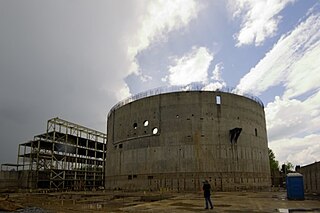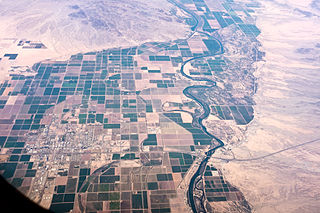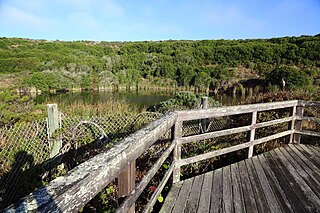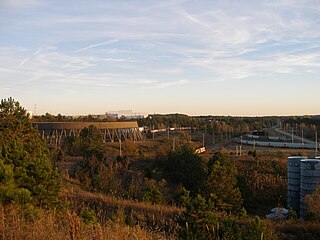South River Nuclear Power Plant was proposed by Carolina Power & Light in 1973 as three Babcock & Wilcox 1,150 MW units, but the project was canceled in 1978. [1]
The late 1960s and early 1970s saw a rapid growth in the development of nuclear power in the USA. By 1976, however, many nuclear plant proposals were no longer viable due to the downturn of electricity demand increases, significant cost and time overruns, and more complex regulatory requirements. Also, there was considerable public opposition to nuclear power in the US by this time, which contributed to delays in licensing planned nuclear power stations. [2]
The Black Fox Nuclear Power Plant was a nuclear power plant proposed by the Public Service Company of Oklahoma (PSO) in May 1973. It was cancelled in 1982.

The Cherokee Nuclear Power Plant is an uncompleted energy project 10 miles (16 km) outside Gaffney, South Carolina, United States. In the early 1970s, Duke Power started construction on a three-reactor nuclear power plant at the site. However, the project stalled due to economic problems by the early 1980s, leading to the project's eventual abandonment. In 1987, the power plant was the site of an underwater film studio built by Hollywood director James Cameron, for the film The Abyss.
The William States Lee III Nuclear Station was a planned two-unit nuclear power plant in Cherokee County, South Carolina. Duke Energy filed the Combined Construction and Operating License (COL) application for the plant on December 13, 2007 to the NRC. On December 19, 2016, the NRC issued two Combined Licenses authorizing Duke to build and operate two AP1000 reactors at the site.
The Alan R. Barton Nuclear Plant was a proposed commercial nuclear power plant in central Alabama, United States.

Between 2007 and 2009, 13 companies applied to the Nuclear Regulatory Commission (NRC) for construction and operating licenses to build 31 new nuclear power reactors in the United States. However, the case for widespread nuclear plant construction has been hampered due to inexpensive natural gas, slow electricity demand growth in a weak US economy, lack of financing, and safety concerns following the Fukushima nuclear disaster at a plant built in the early 1970s which occurred in 2011.

The Sundesert Nuclear Power Plant was a proposed California nuclear power station, formally submitted in 1976. Facing firm opposition from the state's Governor Jerry Brown and denied a permit by a state agency, plans for the construction of the power facility were rejected in 1978 after 100 million dollars had been spent towards its construction. The Sundesert proposal was the last major attempt to build a nuclear plant in California.

The Bodega Bay Nuclear Power Plant was a proposed Northern California nuclear power facility that was stopped by local activism in the 1960s and never built. The foundations, located 2 miles (3.2 km) west of the active San Andreas Fault, were being dug at the time the plant was cancelled. The action has been termed "the birth of the anti-nuclear movement."

The Yellow Creek Nuclear Plant is a canceled nuclear power plant project near Iuka, Mississippi. It was originally planned to have two 1,350-MW (output) reactors operated by the Tennessee Valley Authority (TVA). The steam turbine-generator sets were provided by General Electric.
The Montague Nuclear Power Plant was a proposed nuclear power plant to be located in Montague, Massachusetts. The plant was to consist of two 1150 MWe General Electric boiling water reactors. The project was proposed in 1973 and canceled in 1980, after $29 million was spent on the project.
Sears Isle Nuclear Power Plant was a nuclear power plant proposed by Central Maine Power in 1974 as a single 1,150 MW nuclear reactor built by Westinghouse. It was to be built on Sears Island in Maine, but the project was canceled in 1977.
Stanislaus Nuclear Power Plant was proposed by Pacific Gas & Electric in 1971 as two GE 1,200 MW units, but the project was canceled in 1979.
The Allens Creek Nuclear Power Plant was a proposed nuclear power plant to be located at Wallis, Texas, less than 50 miles from the western edge of Houston. The plant, consisting of two 1,150 MWe General Electric boiling water reactors, was ordered by Houston Lighting and Power Company (HL&P) in 1973, but public opposition, fueled in part by press coverage of problems at other nuclear plants around the country, led to lengthy public hearings and court action. In the meantime, construction costs escalated and the plant was officially canceled in 1982.
The Atlantic Nuclear Power Plant was a proposed floating nuclear power plant located off the coast of New Jersey. It was proposed in the 1970s by the Public Service Electric and Gas Company. Two Westinghouse 1,150 MWe (net) pressurized water reactors were ordered in 1972, and another two Westinghouse 1,150 MWe (net) reactors were ordered in 1973. The four unit power plant proposal was canceled in 1978.
The Blue Hills Nuclear Power Plant was a proposed commercial nuclear power plant 20 miles northeast of Jasper, Texas. It was proposed in the 1970s by the Gulf States Utilities Company. One 918 MWe pressurized water reactor was ordered in 1973, and an additional 918 MWe reactor was ordered in 1974 from Combustion Engineering. The two unit power plant proposal was canceled in 1978.
The Erie Nuclear Power Plant was a proposed nuclear power plant to be located 9 miles (14 km) southeast of Sandusky, Ohio. It was proposed in 1976 by Ohio Edison for the Central Area Power Coordination (CAPCO). The plant was to consist of two Babcock & Wilcox 1,267 megawatt reactors. Unit 1 was scheduled to be complete in 1986, Unit 2 in 1988. Preliminary work was canceled in 1980 due to new federal requirements placed on nuclear plants that make their construction more expensive and by a drop in anticipated customer energy demand.
The Forked River Nuclear Power Plant was a proposed nuclear power plant in Lacey Township in Ocean County, New Jersey. It was proposed as a single 1,070 MW reactor in 1969 to be built by Combustion Engineering and operated by Jersey Central Power and Light. The facility would have been located on a site between JCP&L's existing Oyster Creek Nuclear Generating Station and the Garden State Parkway. Unlike the Oyster Creek Plant, the Forked River Plant would have a cooling tower to prevent the release of hot water into Oyster Creek and Barnegat Bay.
The Greene County Nuclear Power Plant was proposed in 1974 by the Power Authority of the State of New York. A single 1,212 MWe Babcock & Wilcox pressurized water reactor was to be built approximately 5 miles south of Catskill, New York on the western shore of the Hudson River, but the plant proposal was canceled in 1979, largely due to concerns over social and economic disruptions to the local communities.

The Haven Nuclear Power Plant was a proposed nuclear power plant in Haven, Wisconsin north of Sheboygan at the site of closed military camp called Camp Haven. The power plant was proposed in the 1970s by Wisconsin Electric, but was never built. Two 900 MWe Westinghouse pressurized water reactor were proposed in 1973. Reactor one was canceled in 1978 and reactor two was canceled in 1980. After plans never materialized, the Kohler Company purchased the site. Construction of the Whistling Straits golf course began in 1995.
The Bailly Nuclear Power Plant was a nuclear power plant project to be located near the Indiana Dunes National Lakeshore in Porter County, Indiana, United States. The project was proposed by the Northern Indiana Public Service Company (NIPSCO) in 1967; however, it was cancelled in 1981.